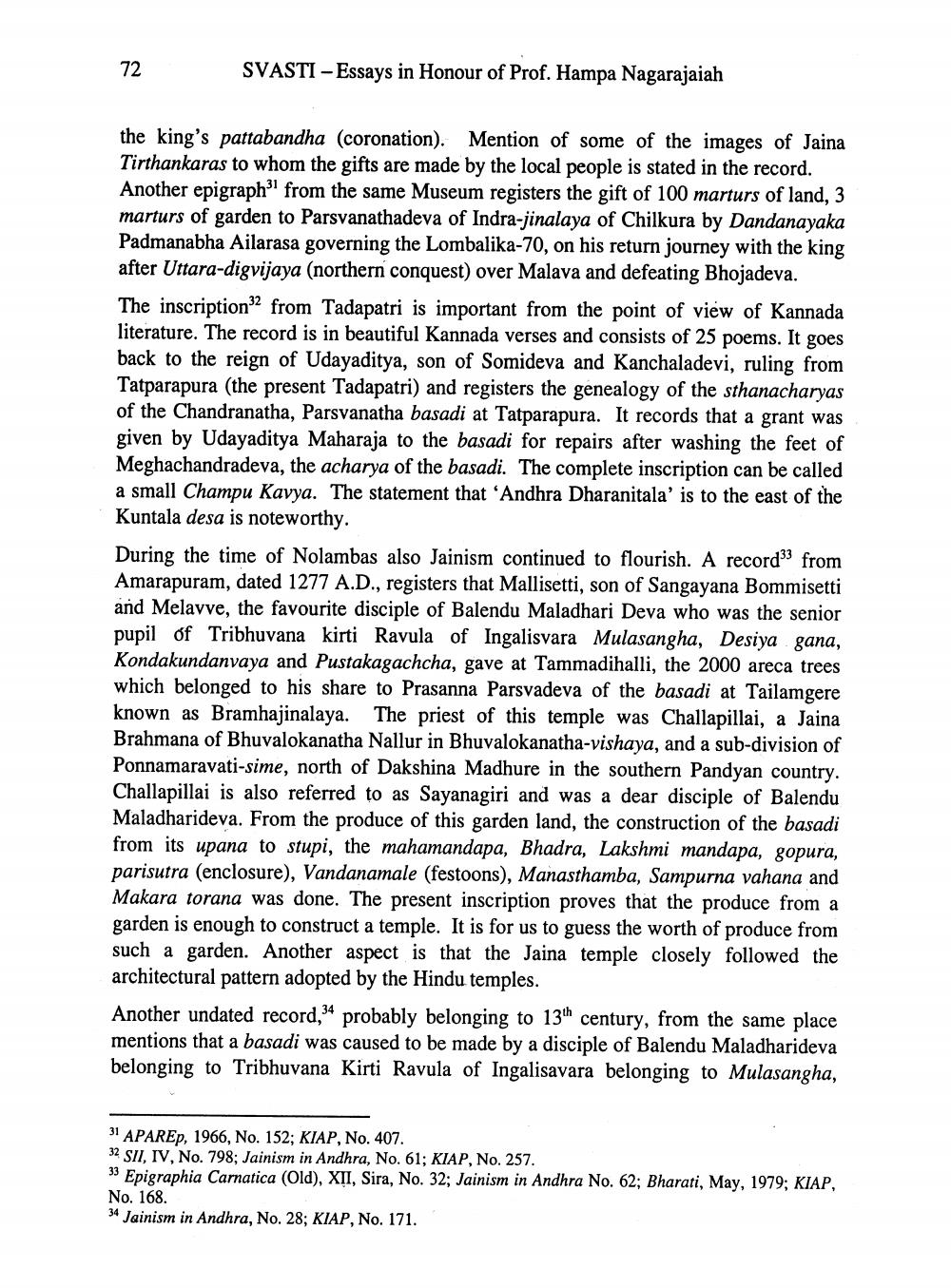________________
72
SVASTI - Essays in Honour of Prof. Hampa Nagarajaiah
the king's pattabandha (coronation). Mention of some of the images of Jaina Tirthankaras to whom the gifts are made by the local people is stated in the record. Another epigraph” from the same Museum registers the gift of 100 marturs of land, 3 marturs of garden to Parsvanathadeva of Indra-jinalaya of Chilkura by Dandanayaka Padmanabha Ailarasa governing the Lombalika-70, on his return journey with the king after Uttara-digvijaya (northern conquest) over Malava and defeating Bhojadeva. The inscription from Tadapatri is important from the point of view of Kannada literature. The record is in beautiful Kannada verses and consists of 25 poems. It goes back to the reign of Udayaditya, son of Somideva and Kanchaladevi, ruling from Tatparapura (the present Tadapatri) and registers the genealogy of the sthanacharyas of the Chandranatha, Parsvanatha basadi at Tatparapura. It records that a grant was given by Udayaditya Maharaja to the basadi for repairs after washing the feet of Meghachandradeva, the acharya of the basadi. The complete inscription can be called a small Champu Kavya. The statement that 'Andhra Dharanitala' is to the east of the Kuntala desa is noteworthy. During the time of Nolambas also Jainism continued to flourish. A record” from Amarapuram, dated 1277 A.D., registers that Mallisetti, son of Sangayana Bommisetti and Melavve, the favourite disciple of Balendu Maladhari Deva who was the senior pupil of Tribhuvana kirti Ravula of Ingalisvara Mulasangha, Desiya gana, Kondakundanvaya and Pustakagachcha, gave at Tammadihalli, the 2000 areca trees which belonged to his share to Prasanna Parsvadeva of the basadi at Tailamgere known as Bramhajinalaya. The priest of this temple was Challapillai, a Jaina Brahmana of Bhuvalokanatha Nallur in Bhuvalokanatha-vishaya, and a sub-division of Ponnamaravati-sime, north of Dakshina Madhure in the southern Pandyan country. Challapillai is also referred to as Sayanagiri and was a dear disciple of Balendu Maladharideva. From the produce of this garden land, the construction of the basadi from its upana to stupi, the mahamandapa, Bhadra, Lakshmi mandapa, gopura, parisutra (enclosure), Vandanamale (festoons), Manasthamba, Sampurna vahana and Makara torana was done. The present inscription proves that the produce from a garden is enough to construct a temple. It is for us to guess the worth of produce from such a garden. Another aspect is that the Jaina temple closely followed the architectural pattern adopted by the Hindu temples. Another undated record, 34 probably belonging to 13th century, from the same place mentions that a basadi was caused to be made by a disciple of Balendu Maladharideva belonging to Tribhuvana Kirti Ravula of Ingalisavara belonging to Mulasangha,
31 APAREp, 1966, No. 152; KIAP, No. 407. 32 SII, IV, No. 798; Jainism in Andhra, No. 61; KIAP, No. 257. 33 Epigraphia Carnatica (Old), XII, Sira, No. 32; Jainism in Andhra No. 62; Bharati, May, 1979; KIAP, No. 168. 34 Jainism in Andhra, No. 28; KIAP, No. 171.




